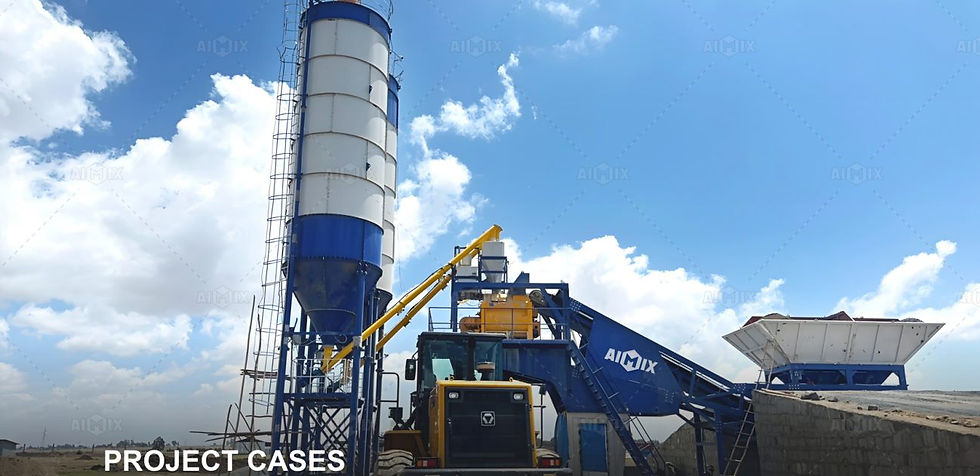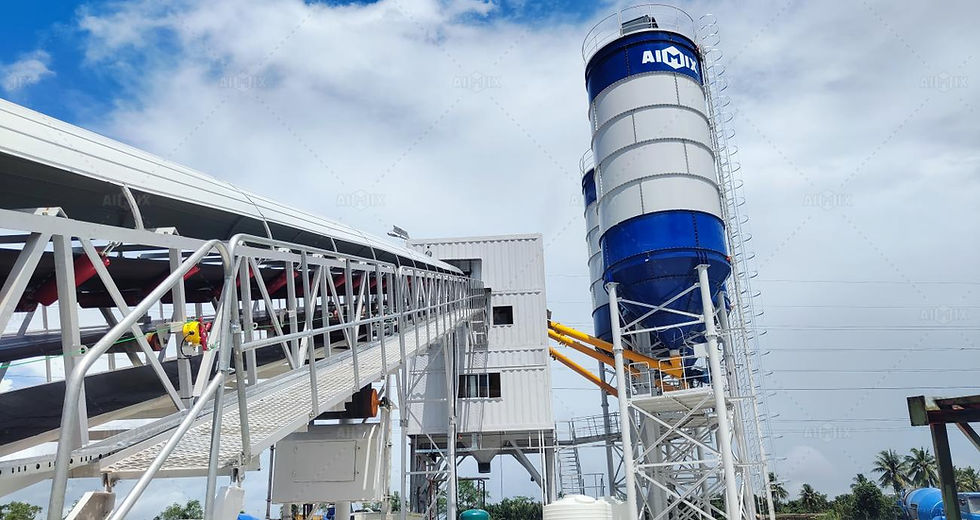How Operational Efficiency Can Influence Concrete Batch Plant Prices Over Time
- aimixglobal5
- Dec 8, 2024
- 5 min read
Investing in a concrete batch plant is a major decision for construction businesses. It’s not just the upfront cost of purchasing the plant that matters; long-term operational efficiency plays a crucial role in determining the overall cost-effectiveness of the plant. Operational efficiency refers to how well a plant uses its resources—such as labor, energy, materials, and time—to produce quality concrete in the most cost-effective manner. This article will explore how operational efficiency can influence concrete batch plant prices over time and help you maximize the value of your investment.

1. Reduced Maintenance Costs
A well-maintained and efficiently operated concrete batch plant typically requires fewer repairs and maintenance over its lifetime. Regular and preventive maintenance ensures that components such as mixers, batching systems, conveyors, and control panels are operating at peak performance, minimizing wear and tear. The more efficiently these systems function, the less likely they are to break down, which translates to reduced repair and replacement costs.
Efficient operation also extends the lifespan of critical components, meaning that businesses won’t need to reinvest in parts and equipment as frequently. Over time, this reduction in maintenance costs can significantly lower the total cost of ownership, directly impacting the bottom line and offsetting the initial price of the plant.
2. Reduced Energy Consumption
Concrete batch plants consume a substantial amount of energy, especially for large-scale operations. However, operational efficiency plays a major role in reducing energy consumption, which can have a significant impact on long-term costs. Efficient batching systems, optimized mixing processes, and energy-saving technologies (such as energy-efficient motors and variable-speed drives) can all help minimize energy usage without compromising on productivity or concrete quality.
For example, automated control systems that optimize batching recipes, mixing times, and ingredient ratios can prevent unnecessary energy consumption. Additionally, integrating technologies like solar panels or waste heat recovery systems can further cut down on energy costs over time.
By operating more efficiently, businesses can reduce their utility expenses and improve the financial return on investment of the batch plant, which influences the plant’s overall pricing in the long run.

3. Minimized Material Waste
One of the most significant ways operational efficiency influences concrete batch plant prices over time is by minimizing material waste. Efficient batching systems can ensure that the exact amount of raw materials—cement, sand, aggregates, and water—are used for each batch of concrete. This reduces overordering, excess waste, and costly disposal fees.
In addition, automated control systems help reduce human error in measuring and mixing materials, ensuring a more consistent product and eliminating the need for reworks due to poor-quality concrete. With less material waste and fewer production errors, businesses can optimize their use of raw materials, which not only lowers production costs but also reduces the overall cost of concrete per cubic meter.
Moreover, an efficient plant helps businesses remain competitive by offering more competitive pricing for concrete, giving them an edge in the marketplace. If you are looking for a concrete plant solution for your business, you are advised to choose and cooperate with a reliable batching plant manufacturer to get an ideal product at competitive price.
4. Faster Production and Increased Throughput
An efficient concrete batch plant reduces production time, leading to faster turnaround times and an increase in the overall throughput. Through optimized batching processes, such as faster loading, mixing, and delivery systems, an efficient plant can produce more concrete per day or shift. This increase in throughput directly contributes to maximizing revenue, as more concrete can be produced and sold in the same period of time.
Faster production also translates to fewer delays for construction projects, which can reduce costs associated with idle time or penalties for late deliveries. For contractors and project managers, knowing that a concrete plant can produce large quantities of concrete efficiently and quickly means fewer disruptions, more consistent work schedules, and a smoother project timeline.
In the long run, this operational efficiency leads to a higher return on investment, making the initial price of the plant more worthwhile.
5. Improved Labor Productivity
Operational efficiency doesn’t only refer to the machinery and equipment; it also involves the workforce. A well-designed batch plant, coupled with an optimized workflow, reduces the time and labor required for operations. Automated systems, for instance, minimize the need for manual intervention, which can lead to fewer labor hours per batch produced.
By streamlining tasks such as batching, mixing, and quality control, an efficient plant enables operators to focus on other essential tasks, increasing overall labor productivity. More productive workers mean fewer labor costs for the same or greater output, reducing the price per cubic meter of concrete produced.
Moreover, training operators on how to work with automated systems or maintain equipment effectively can further improve efficiency, ensuring that labor costs remain manageable over time.

6. Cost-Effective Upgrades and Scalability
As your business grows, you may need to scale your concrete batch plant to meet increased demand. Efficient plants are often easier to upgrade with additional equipment, such as larger mixers, more storage silos, or expanded batching systems, without a substantial increase in operating costs.
Choosing a plant with scalable and adaptable features from the start can help businesses avoid high capital expenditures when demand rises. Efficient plants allow for smoother integration of these upgrades, helping to keep costs down while increasing output.
Upgrading a plant with energy-saving features or automated control systems can also make it more efficient over time, reducing operational costs and improving profitability.
7. Long-Term Return on Investment (ROI)
While the initial cost of a concrete batch plant is often a major concern, a plant that operates efficiently over time provides a substantial return on investment (ROI). As energy costs drop, material waste decreases, production increases, and labor becomes more productive, businesses will see a quicker payback period for their initial investment.
Efficient operations translate to a higher ROI, as the ongoing savings in operational costs effectively offset the initial plant purchase price. As a result, companies can reinvest these savings into new projects or other operational improvements, ultimately enhancing the long-term financial health of the business.
Conclusion
The efficiency with which a concrete batch plant operates plays a critical role in determining its long-term costs. Operational efficiency can influence many factors, from maintenance and energy consumption to material waste and labor costs. By optimizing plant operations, businesses can not only reduce ongoing expenses but also increase productivity and throughput, ultimately improving the plant’s ROI.
For construction companies considering the purchase of a concrete batch plant, it’s crucial to look beyond the initial purchase price and evaluate how operational efficiency will impact the total cost of ownership over time. By making strategic decisions about plant design, equipment, and processes, businesses can ensure they maximize the value of their investment while keeping operational costs in check.







Comments